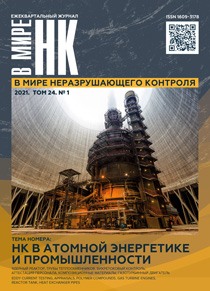Obninsk, Russian Federation
Obninsk, Russian Federation
Obninsk, Russian Federation
Kazan, Russian Federation
Kazan, Russian Federation
Obninsk, Russian Federation
Introduction. The research considers the NDT results with through-transmission ultrasonic techniques of samples of adhesive joints and three-layer polymer composite structures with artificial defects simulating the common failures of parts for aerospace equipment. The purpose of the conducted research was to determine the detectability of common defects in such structures during an automated ultrasonic testing. A set of samples prepared for the research had artificially embedded defects, simulating the delamination of skins and disbonds of adhesive joints. The set consisted of four types of samples with different skin material; with different material, height and size of honeycomb cells (for three-layer structures) and with different types of adhesive joints — for reinforced stringer structures. Method. These samples were analyzed using two types of automated through-transmission ultrasonic techniques. The first type is transmission of ultrasound through a layer of air, the second type is through a jet of water. Two automated systems were used:, a Technische Beratung Schittko GmbH machine for the first case, and Tecnatom robotic system for the second case. Pseudocolor C-scan is a diagnostic testing document for both systems. C-scan analysis is based on the thresholding method. Results 1. The inspection of stringer samples demonstrated that they can be inspected with a non-contact technique using an air inlet at frequencies of 40 and 500 kHz with a sensitivity of at least 1 cm2. The water jet inspection of adhesive joints at frequencies of 1 MHz and 5 MHz can provide a sensitivity of 0.3 cm2. 2. All samples of three-layer structures, including honeycomb cores of various thicknesses, turned out to be uninspectable when tested with an air inlet at a frequency of 500 kHz. 3. Three-layer structures with a honeycomb core height of up to 8 mm can be inspected with the non-contact through-transmission ultrasonic technique at a frequency of 40 KHz with a sensitivity of 5 cm2. Such structures can also be inspected with the jet method at a frequency of 1 MHz with a sensitivity of 1 cm2. 4. Three-layer structures with a honeycomb core height of 80 mm and more cannot be inspected with the through-transmission ultrasonic technique using an air inlet due to the significant ultrasonic attenuation. They can be inspected with the jet method at a frequency of 1 MHz with a sensitivity of 1.8 cm2. Conclusion. Automated through-transmission ultrasonic testing of three-layer structures and adhesive joints ensures reliable detection of defects with a diameter of 15 mm for adhesive joints of monolithic parts and detection of defects with a diameter of 15–25 mm for three-layer structures, depending on the thickness of the skin and core.
polymer compounds, UT, transducer, mode, adaptive quantization, probability distribution, ultrasonic signal thresholding
1. Hillger W., Ahrholdt M., Rohling H., Henrich R. Non-Contact Ultrasonic Imaging Techniques for Composite Components. - In: 16th World Conference on NDT/Conf. Proc. on CD. - Montreal, Canada: 2004.
2. Hsu D. K., Barnard D. J., Peters J. J., Polis D. L. Application of air-coupled ultrasound in NDE of composite space structures. - In: Rev. of Progress in Quantitative NDE. V. 23. / AIP Conf. Proc. - Melville, NY: 2004, r. 851-858.
3. Aguado C. E. Innovative Non-Destructive Testing Applied to Detection and Evaluation of Defects. - Madrid, Spain: Tecnatom, 2012. - 75 p.
4. Ckorobogat L. I., Ivanov V. G. Matematicheskoe obespechenie avtomatizirovannoy sistemy ul'trazvukovogo kontrolya. - Defektoskopiya. 1988. № 11. C. 65-72.
5. Abels C., Schittko H., Spitzke W. Pruefroboter fuer grosse Bauteile. - Metall Wirtschaft, Wissenschaft und Technik. 1985. Bd 39. H. 4. S. 339-342.
6. Ivanov V. G., Ckorobogat L. I. Avtomaticheskiy ul'trazvukovoy kontrol' kompozitov katyaschimisya preobrazovatelyami. - Defektoskopiya. 1990. № 5. C. 30-37.
7. Muhin N. V., Starikovskiy G. P., Ivanov V. G. i dr. Avtomatizirovannyy ul'trazvukovoy beskontaktnyy kontrol' izdeliy iz PKM. - V kn.: XIX Mezhd. nauchno-tehn. konf. «Konstrukcii i tehnologii polucheniya izdeliy iz nemetallicheskih materialov»/ Tezisy dokladov. - Obninsk: GNC RF FGUP «ONPP “Tehnologiya», 2010, s. 65-66.
8. Bhardwaj M. C. High Efficiency Non-Contact Transducers and a Very High Coupling Piezoelectric Composite. - - In: 16th World Conference on NDT/Conf. Proc. on CD. - Montreal, Canada: 2004.
9. Dokumentaciya po ekspluatacii avtomatizirovannoy sistemy UZ kontrolya Tecnatom B161-GEN-TGL-01. -Madrid, Ispaniya: Tecnatom, 2013. - 201 s.
10. Prett U. K., Fozhra O. D., Gagalovich A. Primenenie modeley stohasticheskih tekstur dlya obrabotki izobrazheniy. - TIIER / Per. s angl. - M.: Mir. 1981. T. 69. № 5. C. 54-64.
11. Rozenfel'd A., Deyvis L. S. Segmentaciya i modeli izobrazheniya. - Tam zhe. 1979. T. 67. № 5. S. 71-81.
12. Belikova T. P., Yaroslavskiy L. P. Ispol'zovanie adaptivnyh amplitudnyh preobrazovaniy dlya preparirovaniya izobrazheniy. - Voprosy radioelektroniki. Ser. obschetehn. 1974. Vyp.14. S. 88-98.
13. Yaroslavskiy L. P. Vvedenie v cifrovuyu obrabotku izobrazheniy. - M.: Sov. radio, 1979. - 312 s.
14. Pavlidis T. Algoritmy mashinnoy grafiki i obrabotki izobrazheniy. - M.: Radio i svyaz', 1986. - 399 s.
15. Blake R. A., Scott W. R. Pseudocolor C-scan with quantitative image histogram evaluation and enhancement. - In: Proc. 14-th Symp. Nondestruct. Eval. - San Antonio, Tex.: 1983, p. 175-181.
16. Ivanov V. G. Avtomaticheskoe razdelenie po porogu pri cifrovoy obrabotke ul'trazvukovyh defektoskopicheskih izobrazheniy izdeliy iz kompozitov. - Defektoskopiya. 1990. № 5. C. 37-43.
17. Mott G., Taszarek B.J. Ultrasonic characterization of an interference fit. - Mater. Evaluation. 1985. V. 43. No. 8. P. 990-994.
18. Trifonova S. I., Generalov A. S, Dalin M. A. Sovremennye tehnologii i sredstva tenevogo ul'trazvukovogo kontrolya polimernyh kompozicionnyh materialov. - V mire NK. 2016. T. 19, № 1. C. 31-35.





